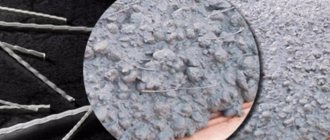July 22, 2021
Asphalt concrete is produced artificially to be used primarily in road construction. The difficulty is that the term “asphalt concrete” hides dozens of mixtures with different sets of characteristics. Some are intended for sidewalks and playgrounds, others for parking lots, and others for highways. We decided to figure out what types of asphalt concrete pavements exist and how to choose the right one.
What is asphalt made from - the main components
Asphalt concrete is made at asphalt plants from bitumen and solid fillers. Artificial asphalt can include many other components depending on the purpose of the roadway and operating conditions.
- Coarse filler . This is crushed stone of various rocks or sedimentary rocks. Its purpose is to give the asphalt concrete pavement hardness and resistance to increased mechanical loads. A fraction of 10–40 mm is allowed.
- Fine-grained filler . The purpose of this component is to reduce porosity and increase the density of asphalt. To do this, quarry sand or crushed stone screenings are added to asphalt concrete. This filler improves the resistance of road pavements to high temperatures.
- Mineral powders . With their help, the viscosity of the mixture is adjusted.
- Bitumen . It is the main binding component of artificial asphalt. Some asphalt plants use other synthetic plasticizers, but this technology is more expensive and is only used for special road surfaces.
How thick can an asphalt concrete pavement be?
The thickness of the coating is determined by the type of area being paved. For example, for a sidewalk, one 3- or 4-centimeter layer is sufficient. But for a highway with high loads it can reach up to 30 cm.
The asphalt used during installation is of great importance. For example, a sand mixture requires more than a crushed stone mixture, since the physical and mechanical properties of the latter are definitely higher.
For reference! If a high-density coating is required, several layers of asphalt concrete will have to be laid. In this case, consider a number of important factors:
- Each layer is separately compacted to ensure a durable coating.
- To increase adhesion between layers, impregnation with bitumen emulsion is used.
- To strengthen the coating, which will be subject to particularly high loads, geogrid can be used.
Geogrid can significantly increase the strength and durability of asphalt concrete pavement. It strengthens the canvas and evenly distributes the vertical load along the horizontal plane.
Types of asphalt concrete mixtures
Russian GOST 9128–2013 provides for three types of asphalt depending on the solid filler fraction.
- Coarse-grained asphalt concrete mixtures are used to lay the bottom layer of road pavement. For its production, asphalt plants use both coarse crushed stone 20–40 mm in size and small fractions 5–15 mm.
- Fine-grained - the top layer of the road surface. The composition of such asphalt concrete includes fine crushed stone with a grain size of 5–15 mm as a filler.
- Sandy - for sidewalks and garden paths. The main filler in such asphalt is sand, screenings and some fine crushed stone with mineral powder.
Asphalt plants produce several types of asphalt concrete mixtures depending on their composition.
- Classic asphalt is universal, suitable for road construction work in cities and rural areas, for the construction of roads and pedestrian sidewalks.
- Crushed stone-mastic - high-strength, suitable for laying suburban highways with heavy traffic. The composition includes stabilizing fiber additives.
- Polymer asphalt concrete is strong and durable, suitable for the construction of runways, bridge coverings and driveways for massive military and special equipment. The composition includes copolymer components and plasticizers.
Asphalt is also classified depending on production technology. These can be hot, cold or warm asphalt concrete mixtures
Start of using asphalt for road construction
The first mention of the use of natural asphalt for laying roads dates back to the 16th century and South America. The production of artificial cast asphalt mixtures appeared in the USA only at the end of the 19th century; bitumen-mineral compositions came to the streets of Europe a little earlier - in 1830-40. paved sidewalks and roadways in cities in France, Austria, Great Britain and Russia began to be replaced by asphalt surfaces.
The first trial and larger-scale asphalt paving experiment was carried out in St. Petersburg, but only by 1980. the new road material spread to other major cities. At the same time, our own plant was not built in Russia right away - for three decades, the then progressive product was purchased abroad.
America was again the pioneer in mechanized laying. It was here that a tarmacrator, from which hot bitumen poured, was first used to build a road.
Hot and warm asphalt concrete - manufacturing technology
The operating temperature of hot asphalt is about 110°C, warm asphalt mixtures are from 40 to 80°C. This is a classic technology for laying asphalt road and sidewalk pavements, which consists of thermal plasticization of bitumen and its hardening after laying, leveling and rolling.
Most asphalt plants use classic hot asphalt production technology.
- The crushed stone is dried at a temperature of about 150°C and then sifted on a screen. The solid filler is supplied to the asphalt plant in a wet state, which is unacceptable in the production of asphalt concrete.
- Mixing the filler with bitumen at a temperature of about 170°C, which is maintained until the asphalt is laid.
- Adding additives and modifiers. These are components that improve the operational and laying characteristics of asphalt concrete.
Ready hot can be stored for no more than two days. It has strict seasonal boundaries - summer and dry, warm weather in spring and autumn.
Hot asphalt and step-by-step instructions for its production
The main components of this material are crushed stone, ordinary river sand, bitumen resin, as well as polymer materials for laying on the surface. The last component is not always used, as it is expensive; it is used mainly in the construction of highways and highways. Despite the fact that all the components can be found in the shed, making a road surface at the dacha will be a little difficult. You should seriously prepare for this process
We need a container for mixing the “ingredients”, a fire (can be a fire) for 6-8 hours continuously, about 100 liters of water to cool the suspension, as well as one of the pastes to keep everything together. Its role can be played by resin or bitumen (preferred). Let's look at the manufacturing instructions step by step.
Step 1
Prepare the container.
The first step is to make a prototype of a concrete mixer, since it would be irrational to “kill” an expensive and useful item. For our purposes, a metal barrel of oil or diesel fuel, in which a branded product is sold, is suitable. If you don’t have one, you can buy it for pennies (or borrow it for free) from any farmer or from the company itself that bottles oil into retail containers. They are often thrown into scrap metal as industrial waste. Close the lid and drill holes in the bottom center with an electric drill. We thread a metal rod (pipe, angle, square, etc.) and scald it using inverter welding so that there are no leaks anywhere. We weld an L-shaped twig to one of the edges, creating a “skewer”.
Step 2
Mix the components.
We pour crushed stone into our “concrete mixer”, add a little sand (2:1) and mix everything thoroughly. You cannot pick up wet building materials - they will immediately stick together, and it will be very difficult to pick them out from the metal walls.
Step 3
We heat the bitumen and polymer additives.
In a separate container (it is best to take a 15-liter bucket), we need to heat the bitumen to a boil; for better elasticity, you can add shampoo to it. It will burn out later, but it will be much more convenient to stir. We also add polymers and plasticizers there.
Step 4
Mix everything together.
You don’t need a lot of imagination here, just take and add boiling bitumen to a preheated barrel with crushed stone and sand. Important: do not mix if the barrel and all components are not warmed up - the bitumen will quickly cool down and mixing will be impossible. For convenience, you can first add 50 liters of water to a barrel and bring to a boil. After this, pour in bitumen and stir until the water evaporates.
The boiling point of water is 100 degrees, exactly what we need for bitumen to make it fluid and sticky. Remember not to overheat this material - it ignites at a temperature of 170 degrees, so watch the water. Just finished - pour it out!
Step 5
Pour into the holes.
The area in which you will pour asphalt must be thoroughly cleaned, preferably blown out with a compressor. After you pour in the hot mixture, you need to take a roller or any other tool (tamper) and compact the material. Be sure to wet the metal of the tool with water so that it does not stick to the bitumen during compaction.
If you follow the instructions, making asphalt at home will be safe, fast and even very interesting!
How cold asphalt is produced
Cold asphalt mixtures are made at asphalt plants from cold bitumen resins and stone fillers in combination with special polymers. Such asphalt concrete has both “pros” and “cons”.
Advantages:
- laying at low temperatures reaching -30°C;
- durability;
- excellent adhesion.
Flaws:
- high price;
- poor shear resistance.
The advantages and disadvantages of cold asphalt limit its scope of application only to pothole repairs of roads and sidewalks. Large-scale road construction using cold asphalt concrete is impractical from either an economic or technical and operational point of view.
Cold asphalt is suitable for the rapid construction of areas and sidewalks that are not expected to be exposed to heavy loads. This can be either a home or garden area, or garden paths.
Cold asphalt is produced using the same technological equipment of asphalt plants that produces hot classic asphalt concrete mixtures. The stages of drying crushed stone, mixing with bitumen and adding additives with subsequent shipment are similar to the technology for producing hot asphalt.
Completion of production
The finished product enters a container, where a small part of it is selected for test control. Samples are tested for strength under pressure from a press and its composition is examined. After passing the quality control department, the hot asphalt is sent for road construction using special trucks.
The finished asphalt will delight everyone who drives or walks on it. Its hard and shock-absorbing surface will keep more than one pair of legs and wheels intact.
Enterprises specializing in the production of asphalt
Plants producing asphalt concrete have complexes of machines, structures, equipment, buildings, and carry out the full cycle of asphalt creation:
- receive and store components for asphalt production;
- crush and sort crushed stone, gravel and sand;
- prepare, dry and mix all ingredients;
- They recycle coatings that have already served their purpose.
Asphalt concrete plants are also divided into cyclic and continuous. Cyclic production uses dispensers, while continuous production assumes that the running production cycle cannot be stopped.
In addition, there are mobile and stationary asphalt mixing plants. Mobile asphalt mixing plants, which each asphalt concrete plant has, are located directly in the places where new road surfaces are laid, since it is impractical to transport ready-made hot mixtures over long distances.
Modern asphalt plants can produce about 400 tons of asphalt per hour.
Preparatory part
In order for asphalt made by yourself to fully perform its assigned functions, it is very important to follow the technology for manufacturing the material and adhere to installation recommendations. The first step in this direction, of course, is preparation.
So, what we need is to prepare all the necessary components (sand, crushed stone, bitumen resin); to ensure the possibility of “cooking” the composition: you will need a large metal container and a heat source (usually a fire is used). And also stock up on a large volume of water as a means of protection (to limit combustion).
Now let's talk about everything in order.
The first thing you should take care of is to make a container for mixing the components, because using a traditional concrete mixer to produce asphalt is an unjustified luxury.
It is quite justified to use a metal barrel (150 - 200 liters) as a container, to the bottom of which it is necessary to weld an L-shaped handle and ensure the ability to rotate the device around its own axis. By the way, you can read about how to make a concrete mixer yourself here.
Next, you should pour the dry ingredients into a metal container (2 parts of sand + 1 part of crushed stone) and mix them thoroughly.
In parallel with this, construction bitumen should be melted in a separate container (usually a large bucket is used). When performing this work, you need to be very scrupulous and take into account the possibility of ignition of the resin (sand and water should be nearby if extinguishing is necessary).
Some experts recommend adding regular shampoo to the bitumen. It will facilitate the mixing process and will evaporate immediately after the resin boils.
The next step is mixing bitumen with sand and crushed stone, for which the heated resin is simply poured into a barrel with bulk substances and mixed thoroughly (by turning). However, when performing this part of the work, it is necessary to take into account the fact that the barrel and the components in it must be well heated. Otherwise, the material will quickly cool down, and high-quality mixing will not be possible.
Water is a good indicator of the readiness of the solution. After all, if you pour hot water into a barrel with bitumen, sand and crushed stone, and then heat the whole substance, you can achieve good results. Well, the readiness of the asphalt will be indicated by the complete evaporation of the liquid from the barrel.
Material laying process
Of course, pouring homemade asphalt concrete onto an unprepared base is not justified. Therefore, before laying the material, it is advisable to clear the work site of debris, dust, or even blow it with air.
After that, the heated asphalt is poured onto the required area and compacted using a hand roller or tamper. It should be noted that in order to minimize the adhesion of the material to the tool, it is advisable to moisten the latter with water.
After hardening, the asphalt is suitable for use.
Methodology for checking the quality of asphalt road surfaces
Each manufacturer of building materials is required to issue the buyer of asphalt a certificate of product quality compliance with state standards. To do this, the plant must have a certified laboratory that can conduct the necessary set of tests. In addition, in all major cities there are independent laboratories for checking the quality of construction and manufacturing of materials.
At a construction site, testing occurs by drilling a core of a given diameter from the road surface and then restoring the road surface. Externally, the quality of the delivered asphalt can be determined by its temperature and the presence of a black, greasy film on the surface.
Laying asphalt pavement
Do-it-yourself installation work begins with making planning decisions and markings. At this stage of work it is necessary to clearly define:
- with the location of the track;
- its width and height above ground level;
- with the type of curb and its installation height;
- with places for laying drainage systems.
When determining the location of the path, you should take into account the presence of possible underground utilities, the location of garden trees and the direction of slopes for rainwater drainage. After making decisions, you need to drive pegs around the perimeter of the future asphalt pavement, defining its exact contours.
Along the marked contour, it is necessary to dig a so-called “trough” or trench, 15 cm deep. Lay a layer of geotextile non-woven fabric on its bottom, which will prevent the germination of weeds and allow moisture to freely drain into the lower layer of soil.
Asphalt laying scheme.
Install and secure the curb and fill the “trough” to the top with crushed stone. The surface must be thoroughly compacted. The durability of the asphalt pavement depends on the quality of the compaction.
Next, you should buy asphalt or prepare it yourself and lay it on top of crushed stone in a layer 4-5 cm thick at a time. Pre-leveling can be done with an inverted rake or a wooden mop.
During the leveling process, it is necessary to check for slopes using a building level. The best way to compact the asphalt concrete layer on a garden path is to use a vibrating rammer.
It should be noted that the process of laying asphalt with your own hands depends on weather conditions. These works should not be carried out at sub-zero temperatures or in damp rainy weather.
Technology for recycling asphalt pavements
The need to save money when repairing and building new asphalt roads led to the development of an effective recycling system (reuse of materials). In this case, the asphalt removed from the road surface is processed, both in stationary factory conditions and in mobile equipment at the work site.
Using this technology, the asphalt concrete coating is removed using a special mechanism with a mechanical cutter - a remixer. Next, the removed material is crushed into a crushed stone fraction and can be used to prepare dry mixtures for the construction of road bases and fills for suburban highways and roads.
Asphalt base.
According to the second technology, the collected and crushed material is placed in a furnace and heated without fire to 170°C with the addition of the required amount of fresh bitumen and additives. This processing method is widely used when repairing city streets and courtyards, since the price, production and laying of asphalt in this case is much lower.
Recycling asphalt at home
An old road surface made from an asphalt mixture allows a home craftsman to arrange comfortable and neat asphalt pedestrian paths on his or her plot, which can easily replace paving slabs. This DIY asphalt can also be used, for example, to cover the floor in a garage or in front of it.
Only the top bitumen layer needs to be removed. The removed material must be broken into pieces as small as possible. The maximum fraction should not exceed 40 mm.
Next, prepare bitumen for mixing with the removed material in a ratio of 1:10 by weight as described above.











